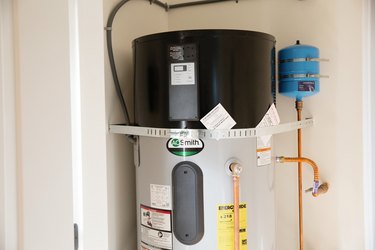Water heaters need occasional draining of the sediment at the bottom of the tank. Even with draining, the sediment builds and eventually makes less room in the tank for water. Sediment coats the heating element in an electric unit, resulting in less efficiency as the water heater ages. Self-cleaning water heaters automatically reduce the sediment that collects in the bottom of the tank.
Tip
Self-cleaning water heaters keep the water circulating inside to keep sediment moving so it can flow through the hot water outlet instead of settling on the bottom.
Video of the Day
Self-Cleaning Water Heaters
Self-cleaning water heaters may operate on electricity or gas. The self-cleaning equipment keeps the water and sediment moving to prevent buildup on the bottom or on the electric element. This self-cleaning turbulence saves the element, prevents leaks and gives you a full tank of hot water even as the water heater gets older. Although the self-cleaning units are an improvement over non-self-cleaning water heaters, they aren't perfect.
Video of the Day
How Water Heaters Work
Whether your water heater is electric or gas, the operation principles for a tank water heater are the same. A cold-water inlet supplies the water to heat; the hot-water outlet supplies hot water to your home. The insulated tank stores hot water until you need it.
When you use hot water, your water heater automatically replaces the hot water with cold water. A dip tube takes the cold water to the bottom of the tank. A self-cleaning water heater has a curved dip tube and a fitting on the dip tube that swirls the incoming water at the bottom of the tank. This keeps the sediment stirred in the water, sending it through the hot-water outlet the next time you use hot water.
The Problem of Sediment
Sediment forms from impurities in your water, primarily calcium carbonate. Keeping the sediment stirred and off the heating element and the bottom of the tank cuts down on damage to the element and scale buildup in the tank. Because the sediment particles are heavier than water, they tend to sink to the bottom, even with the best self-cleaning units.
Accumulated sediment causes the tank to overheat at the bottom, and eventually the water heater leaks. Although the self-cleaning water heater doesn't get all the sediment out of the bottom of the tank, it reduces the buildup and extends the life of the tank and element.
Disadvantages of Self-Cleaning Water Heaters
The self-cleaning water heater costs more at purchase, but you may recoup the initial cost with extended life and efficiency of the unit. A self-cleaning water heater doesn't eliminate all sediment, but the sediment it eliminates goes into your hot water supply.
Using the cold-water tap for your drinking water keeps you from drinking the sediment. Eventually your self-cleaning water heater will build sediment, lose efficiency and lose space for water storage. If your unit has a drain cock at the bottom, you can extend the life of any water heater, even a self-cleaning unit, by draining some water from the bottom.
